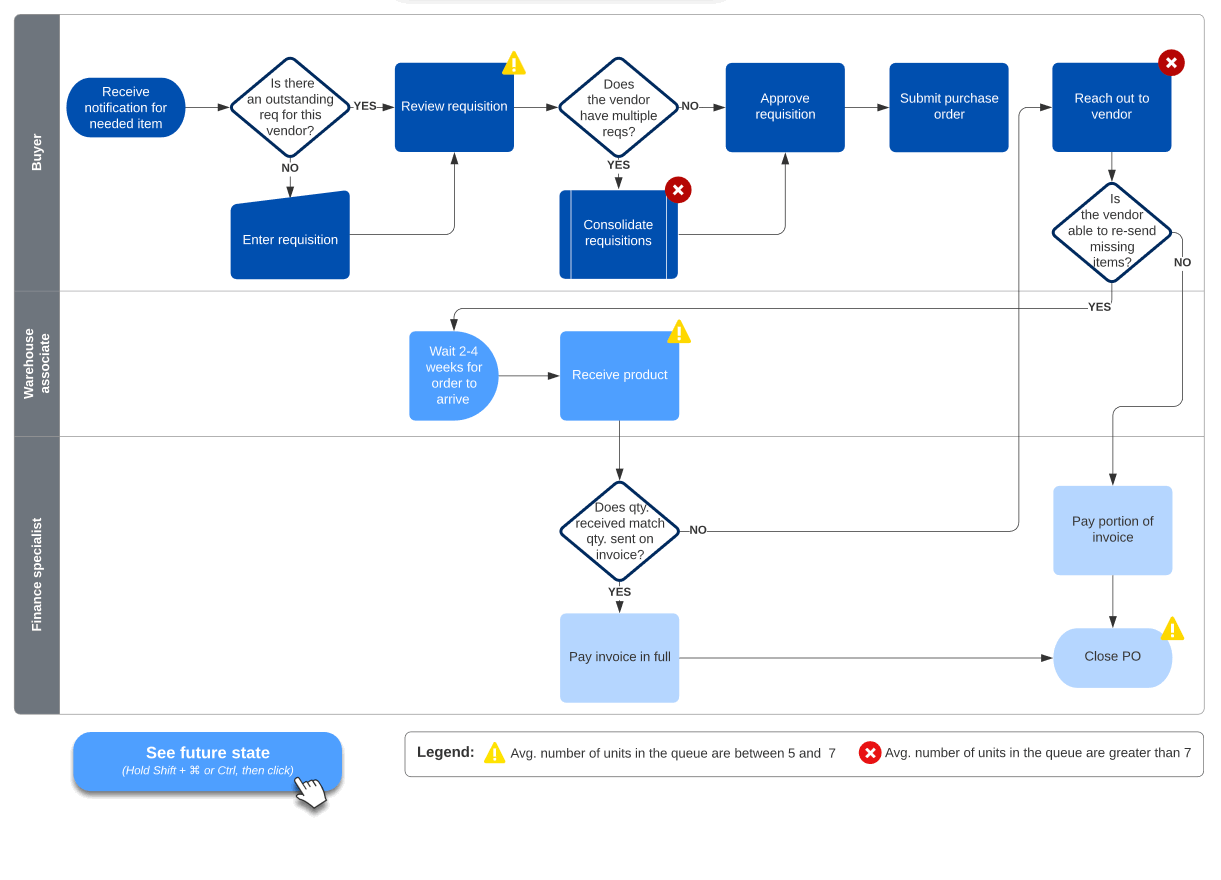
Re-evaluating your goals in the midst of change
Lucid Content
Reading time: about 7 min
Topics:
When was the last time you updated your business plan?
Consistency is an important part of executing a strategy successfully. However, if you aren’t regularly evaluating and updating your business plans and goals to adapt to the changing needs of your business, you risk falling behind and missing key opportunities.
Circumstances and plans change. Whether you’re experiencing rapid growth, undergoing an acquisition, or transitioning to remote work, your plans and goals need to evolve to address a changing business environment.
Use the following tips and strategies for effectively re-evaluating plans and communicating change amid disruption.
When to re-examine your business goals
Evaluating your business plan isn’t like an annual review. You can evaluate your business plans and goals as often as you want, whenever you want. The most important thing is to make sure you examine your plans whenever there is significant change in your business.
Change can come in many forms, including:
- Acquisitions and mergers
- Evolving customer needs
- New legislation
- Technological innovations
- Transitions to remote work
- New business offices or locations
- Shifting marketplace competition
Change may come intentionally as you grow your business or through forces that are out of your control. The key is to adapt your plans strategically.
Pro tip: Evaluate your business goals regularly. Pick a cadence that makes sense for you and your business—whether that is monthly, quarterly, or semi-annually. You can always add more evaluations as needs arise. But checking your plans periodically helps you stay on track with your strategy and identify any goals that are no longer serving your business.
Why you need to re-evaluate during times of change
Business plans and goals help you steer your business. A good business plan acts as a roadmap for decision-making and informs your strategy for setting and achieving key milestones and goals.
However, business plans are not static benchmarks. They should be a living document that you refer to and update regularly.
Re-evaluate your plans and goals often (especially during change or disruption) so you can:
- Stay relevant.
- Match the needs of your business.
- Refresh your brand.
- Take advantage of new opportunities.
If your plans and goals don’t match the current business reality, your strategies will be ineffective and irrelevant—and your business will suffer.
How to re-evaluate your plans
Follow these tips and best practices for re-examining and updating your plans successfully.
Focus on your consumer
If your business plans aren’t serving your target audience—your customers—then they’re not serving you either.
Consider who your consumers are and what they need. Have those needs changed? Don’t make assumptions. Use data and feedback to inform your customer profiles and help you identify areas you need to revise.
Assess whether your goals are still relevant and make sense for your organization
Are you targeting the right goals? If your organization is targeting goals that are no longer relevant or don’t align with your mission, you will waste valuable time, money, and resources.
Examine your current goals and consider how they align with your strategy and current business environment. Don’t be afraid to revise or eliminate goals that no longer make sense with your overall plans. Be specific when outlining your goals and make a plan to achieve your new objectives.
Determine what’s working and what’s not working
What worked in the past may not work in the future. To successfully move forward amidst change, you need to let go of what no longer works and adopt new strategies for progress.
Consider your original plans and compare them to the actual results you saw. Identify key differences between what you planned versus what happened. Why didn’t those plans work? How have the circumstances changed now? What could you do differently going forward?
Answering these questions will help you identify where your plans need to shift and what strategies may still work for you.
Learn how you can better understand your current state and adapt processes to fit your new goals in Lucidchart.
See our tipsIdentify new opportunities for growth
Re-evaluating your plans isn’t just about looking back—it’s about looking forward. Change brings both disruption and opportunities. What opportunities are there now that didn’t exist before?
For example, if you are transitioning to a remote workforce, you may have new opportunities to hire top talent from a more diverse pool of applicants. This can be a significant growth opportunity for companies who struggle to fill talent gaps or are looking for ways to improve their company culture and employee engagement.
Remember to be flexible. Organizational changes to strategic plans and goals takes time.
Communicating change to employees
While change can be good, adapting to change is difficult—especially for employees, who are often the ones most impacted by evolving goals and business processes. So it’s important you communicate changes clearly.
Good communication will help keep everyone on the same page, reduce friction, increase adoption, and streamline the transition.
Communicating change effectively should result in:
- Awareness of the need for change
- Understanding of how it impacts the employee (and the business)
- Support for and ability to implement change
In other words, employees should recognize the need for change and feel empowered to make it happen.
Here are a few ways to communicate change effectively to your employees.
1. Tell employees why this change is needed
The first step to any communication on change is to explain what the changes are and why they are necessary. How will these changes improve the business? What are the benefits to the employees? What are the consequences if you don’t change?
When people know the why, they are more likely to support the change.
2. Clarify expectations to employees for implementing change
How will these changes impact your employees? What are they expected to do?
Changes may affect people directly or indirectly in your organization. The key is to communicate clearly to each group what the expectations are for implementing and supporting those changes.
For example, if you are introducing a new technology to the workflow, when are employees expected to adopt it? Who is responsible for training and onboarding? When will training occur? How can employees provide feedback on the process?
Empower your employees by outlining clear expectations. Visuals, such as process flowcharts or timelines, can help you delineate roles and responsibilities and clarify when each task should be completed.

3. Explain how you are measuring success
Once you make changes, how will you know they worked? What does success look like? Explain how you plan to measure the success of the changes.
This step is especially important for employees whose goals or processes may have shifted. If they don’t know if their efforts are working and can’t confidently measure progress, it will be difficult to:
- Implement changes long-term.
- Maintain employee motivation and engagement.
Outline exactly what the new changes, goals, and performance metrics will be so everyone can track their progress effectively.

Need help getting employees to accept change? Consider these change management models.
Learn more4. Highlight what’s in it for employees
For any change to be successful, you need the support of your employees. Make it easier for them to buy in by highlighting how the changes will positively affect them. For example, will the changes make their job easier? Will they land more clients or close more sales? Are there any incentives you’re willing to offer to make this transition easier?
Recognizing the need for change and adapting your plans is crucial for businesses to remain relevant and competitive.
Regularly re-evaluate the plans you made and assess whether those plans are still relevant and effective. As you re-examine your goals and adapt your strategies to change, your business will be more resilient and better equipped to meet and exceed your goals.

Set goals that match your new business strategy and easily track your progress.
Learn how in LucidchartAbout Lucidchart
Lucidchart, a cloud-based intelligent diagramming application, is a core component of Lucid Software's Visual Collaboration Suite. This intuitive, cloud-based solution empowers teams to collaborate in real-time to build flowcharts, mockups, UML diagrams, customer journey maps, and more. Lucidchart propels teams forward to build the future faster. Lucid is proud to serve top businesses around the world, including customers such as Google, GE, and NBC Universal, and 99% of the Fortune 500. Lucid partners with industry leaders, including Google, Atlassian, and Microsoft. Since its founding, Lucid has received numerous awards for its products, business, and workplace culture. For more information, visit lucidchart.com.
